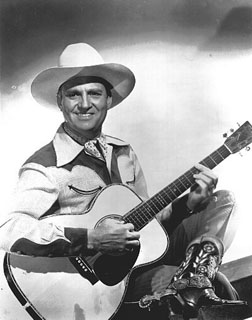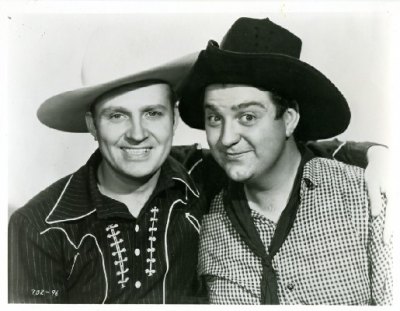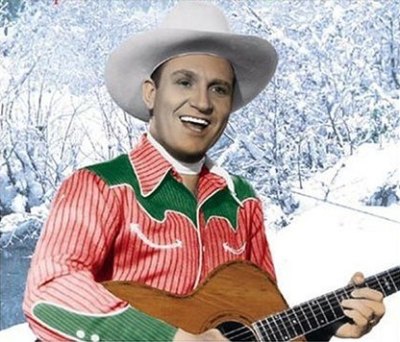| Reviews & Columns |
|
Reviews DVD TV on DVD Blu-ray 4K UHD International DVDs In Theaters Reviews by Studio Video Games Features Collector Series DVDs Easter Egg Database Interviews DVD Talk Radio Feature Articles Columns Anime Talk DVD Savant Horror DVDs The M.O.D. Squad Art House HD Talk Silent DVD
|
DVD Talk Forum |
|
|
| Resources |
|
DVD Price Search Customer Service #'s RCE Info Links |
|
Columns
|
|
|
Gene Autry Collection: Sagebrush Troubadour

Gene Autry, arguably the most popular of all the singing cowboys (he was the only Western star to ever appear in the theatre owners' yearly Top Ten most popular stars lists) was discovered by Will Rogers, who heard him sing, and suggested Gene go into show business. After paying his dues as a singer in local radio, Gene finally broke into movies, quickly starring in his own chapter serial, and then in his own movies, churning them out like hamburger, and building a large, incredibly loyal following at the box office.

It's not hard to see why, when you watch The Sagebrush Troubadour. Autry had a simple, direct, honest connection with the audience that belied any inexperience he had acting in front of the camera. Autry's audience wasn't the same as those for Shaw and Shakespeare, and it didn't matter to them that he wasn't an actor on par with other contemporaries, such as Clark Gable. What Autry's audience wanted, particularly at the peak of his popularity during the Depression and the first dark years of World War II, were pleasant, humable tunes, a lot of quick action with horses, pistols and fists, some low-comedy laughs supplied by sidekick Burnette, and maybe a smooch or two with a pretty gal - all played out under a desert sky. He was the perfect embodiment of the clean-living, clean-looking cowboy, with pearly white teeth in his easy smile, his perfectly starched Western shirt, and his gleaming, glossy pony Champion, carrying him onto his next adventure. And that's what audiences wanted then: escapist adventure. Sure, there were still some small towns out west that may have looked liked the ones in Autry's films, but largely, the films represented as much a fantasy to movie audiences as the Universal monster films that were also popular. What harried man back then didn't wish, just once, that he could drop whatever life he was living and climb onto his faithful steed, to ride off into the desert sun where he might find a pretty girl along with some laughs from his jovial sidekick?
The Sagebrush Troubadour is cleanly made, with a tidy little mystery script that won't fool anybody. It's an efficient 59 minutes, too; nothing is wasted as the story simply gets on with it. It's a shame more films today aren't as economical with their exposition. There's still plenty of time for a couple of songs by Gene and Smiley, along with the requisite dust-up or two, and some heavy-handed romancin' on Gene's part (yup, he spanks Barbara when he first meets her). There's a stark, almost primitive feel to these old westerns that are an acquired taste if you're new to them. There's an elemental look to the proceedings that, at times, even suggests Walker Evans (the excellent silky black and white cinematography is courtesy of Ernest Miller and Jack Marta). As an experiment, I had some of my young children watch the show with me; my older teenager quickly checked out, but my younger son and daughter found it entertaining, no doubt taken with the simple, fast-paced images, and the several songs sung throughout the movie. These early Autry westerns aren't like John Ford westerns; don't expect ambiguity or epic sweep. What the Autry westerns do achieve is a fast-paced, light, easy-going western entertainment that has strong nostalgic appeal for older fans, and perhaps a chance at a broader understanding of the western film tradition, for new viewers.

The DVD:
The Video:
Considerable effort has gone into restoring these early Autry westerns, and it shows, with as clean an image as can be expected from a film over 70 years old. Some of the shots look like they were filmed yesterday. And again, the black and white cinematography, particularly some of the outdoor shots, are silky, silvery smooth.
The Audio:
It appears that the audio has been cleaned up, as well. The mono track seems fairly clear of the snaps, pops and hiss so common with these older titles.
The Extras:
There are quite a few interesting extras on The Sagebrush Troubadour. First is a 16 minute excerpt from the Nashville Network's Melody Ranch Theater," where, in 1987, Autry and Pat Buttram reminisced with Pee Wee King (author of Tennessee Waltz), and told some fun stories about traveling on the road. Next is a KNX Hollywood "Melody Ranch Radio Show," sponsored by Doublemint gum, from 1940, and featuring Gene singing some of his best songs. There's also some production and publicity stills, as well as some production reports, such as paystubs and call sheets, that may be interesting - if we could see them. Unfortunately, the print is small, and I was unable to zoom in on them. Poster and Lobby art follow, which are beautifully rendered in bright, primary colors, as well as some press kit material. There are trivia facts from Alex Gordon about the cast of The Sagebrush Troubadour.
Final Thoughts:
The Sagebrush Troubadour is a sprightly musical mystery from Gene Autry's early days, and it bears noting for its quick pace, unpretentious attitude, and breezy style. Autry is a natural in front of the camera (if not a natural actor), and that's exactly why he's perfect as the singing cowboy that Depression-era audiences wanted to embrace as their own; he was one of them. Recommended.
Paul Mavis is an internationally published film and television historian, a member of the Online Film Critics Society, and the author of The Espionage Filmography.


|
| Popular Reviews |
| Sponsored Links |
|
|
| Sponsored Links |
|
|
| Release List | Reviews | Shop | Newsletter | Forum | DVD Giveaways | Blu-Ray | Advertise |
|
Copyright 2024 DVDTalk.com All Rights Reserved. Legal Info, Privacy Policy, Terms of Use,
Manage Preferences,
Your Privacy Choices | |||||||













